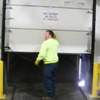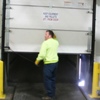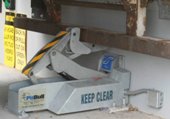
Dock Design for a Changing Workforce
Following these suggestions will promote productivity out of your most experienced workers while avoiding the costs of accidents and injury.
The Baby Boom is reaching retirement, and a growing number of companies are dealing with the need and challenge to replace these older workers. Every seven seconds in this country, someone turns 61, raising concern among management of losing this segment's talent and experience to retirement. This change is finding its way into all areas of the American workforce, notably at the loading dock.
However, with the souring of the economy and the diminishment of 401K savings, many potential retirees are rethinking the notion of replacing the workplace with the golf course. The Bureau of Labor Statistics says about 95 percent of Americans over 65 are willing to continue working full or part time.
According to a recent article in Modern Materials Handling, the CVS drugstore chain is installing material handling equipment at its distribution centers that includes voice-directed picking systems and ergonomic lifting devices to make DC jobs easier for older workers. CVS's Kevin Smith says in the article that, contrary to popular belief, research shows that older workers don't necessarily sustain more injuries. A report by the U.S. Department of Labor supports this conclusion but also finds that fatalities for workers over 55 is 10 percent higher, mostly from transportation incidents, falls, and being hit by an object--which are just the types of accidents that can take place at the loading dock.
The American Society of Safety Engineers lays out suggestions for increasing safety for an aging workforce:
- Eliminate heavy lifts.
- Improve illumination.
- Remove clutter from control panels.
- Make floors skid resistant.
Following these suggestions and setting up the dock with the older worker in mind will ensure that the accident rate and its connected costs diminish greatly.
Eliminate Heavy Lifts
Once a truck is docked, the dockworker usually has to lift the door manually to open it. This kind of motion runs the risk of throwing out a back or pulling muscles, especially if the door is not properly maintained or suffers panel or track damage as a result of forklift impact.
Material handling managers routinely deal with having to repair or replace damaged dock doors from forklift collisions. Unless the door is to the point where it no longer closes properly or cannot be opened at all, managers will generally try to get by with it. When a forklift hits a standard dock door, no matter how slight, it can cause dents and dings that make the door progressively harder to operate. The problem lies with the door guidance system or track, which is similar to a typical garage door. Standard overhead doors run along a sheet-metal track on mushroom-shaped rollers. Both the rollers and the track are rather flimsy, certainly no match for a forklift, and any deformation can make the door difficult to operate. Impacts also can cause the track to flare open, exposing workers to sharp, metal edges.
 Impactable dock doors were introduced in the mid 1990s to combat chronic repair costs and the operating problems resulting from forklift impact. There are impactable door designs available for virtually any application. The most effective impactable doors combine impact-resistant door panels with a spring-loaded guidance system that allows the panel to "break away" from the guides, preventing panel damage. However, the track is another element that needs to be addressed as it relates to impact damage. Standard metal tracks are easily bent upon impact, which could lead to crimping around the roller and making it very difficult to slide the door open or even rendering the door inoperable.
Impactable dock doors were introduced in the mid 1990s to combat chronic repair costs and the operating problems resulting from forklift impact. There are impactable door designs available for virtually any application. The most effective impactable doors combine impact-resistant door panels with a spring-loaded guidance system that allows the panel to "break away" from the guides, preventing panel damage. However, the track is another element that needs to be addressed as it relates to impact damage. Standard metal tracks are easily bent upon impact, which could lead to crimping around the roller and making it very difficult to slide the door open or even rendering the door inoperable.
Look for tracks that incorporate thicker, heavier-gauge steel or UHMW polyethylene plastic. UHMW tracks are especially resilient and can deflect forklift tines when hit. The guides also should have an open design to enable easy travel no matter how many times the guides are hit. Preventing door panel and track damage provides consistent, easy operation for the dockworker, and that equals a consistently safe environment.
Providing a safe and reliable bridge from the dock to the truck trailer is a primary element of any dock safety program. Managers at many operations view mechanically activated edge-of-dock and pit levelers as well as portable dock plates as suitable low-cost, entry-level means for trailer access. However, compared to push-button, powered dock levelers, mechanical levelers and portable plates require a very manual process to activate and position on the trailer.
Many docks with moderate traffic levels have replaced dock plates and edge-of-docks with moderately priced modular dock bridges. A modular dock bridge not only saves installation costs because it requires no concrete pit but also it stores upright protecting dock doors from forklifts. Modular dock bridges can be lowered into position with a slight push and then set back to the vertical position using less than 40 pounds of effort applied to an ergonomically designed handle that requires no bending.
Environments with heavier traffic should consider using air-powered, power-assisted, or hydraulic-powered dock levelers to maintain efficiency and safety. Fully hydraulic dock levelers not only speed up loading times but do not require lifting of chains or any manual interaction other than pushing a button.
Improve Illumination
No matter the workers' ages, the better the visibility the safer the dock. Lighting up the area around the dock and into the truck trailer reduces the potential for forklift accidents and pedestrians tripping over objects or slipping.
As with most pieces of equipment, dock activity puts a special demand on lighting. Along with providing sufficient light inside the trailer, the dock light must be rugged enough to withstand the forklift impacts that seem to seek out everything in the area. The lamp arm must also be flexible to enable illumination of targeted areas inside the truck trailer.
Even the bulbs must be built to take it. When a bulb goes out and dockworkers are in the heat of loading/unloading trucks, drivers are tempted to continue running into the trailers while someone locates a replacement bulb. More and more docks are switching over to longer-life LED lights that have a much hardier life span than incandescents. Shatterproof lenses are also available for food and pharmaceutical operations or other sensitive areas.
LEDs used on light communications systems improve the communication between truck driver and dockworker. LEDs give truck drivers a clear indication of dock status, even in very bright sunlight, and LEDs help dockworkers inside avoid the serious risk of a truck pulling away before loading/unloading is complete.
Declutter the Control Panels
 Master Control Panels are wall-mounted devices that ensure vehicle restraint devices are engaged properly before the door can be opened or the dock leveler deployed. When the truck is ready to hit the road, the control system will disengage the restraint to release the truck only when the dock leveler is stored and the door is closed. Master Control Panels simplify dock equipment training and enable docks to avoid any damage due to operator error. Many of these control panels feature LED lights that are very legible regardless of overall dock illumination.
Master Control Panels are wall-mounted devices that ensure vehicle restraint devices are engaged properly before the door can be opened or the dock leveler deployed. When the truck is ready to hit the road, the control system will disengage the restraint to release the truck only when the dock leveler is stored and the door is closed. Master Control Panels simplify dock equipment training and enable docks to avoid any damage due to operator error. Many of these control panels feature LED lights that are very legible regardless of overall dock illumination.
The panel faces should be designed for ease of use, both by older workers and bilingual employees. Label instructions should be simple, easy to read, and evenly distributed to avoid confusion. Some manufacturers can customize labels with bilingual instructions, company logos, or even a custom background design to help eliminate the intimidation factor that some employees may experience in standard applications with a wall of controls.
Make Floors Skid Resistant
Slips and falls are a constant danger on the dock. The mixture of moisture, debris, and grease is a recipe for dangerous skids. What often triggers these are pedestrians making quick stops or turns to avoid moving forklifts. Avoiding this mix means keeping the dock tightly sealed. The door damage discussed previously can lead to misalignment between the door panels and frame, letting out conditioned air but letting in dirt and moisture, too.
 Also important is providing a good seal around the truck trailer parked at the dock. Dock seals and shelters are available to accommodate a variety of traffic and the routines that take place at a dock. Pay special attention to seal/shelter durability to account for high truck traffic at each dock. Vehicle restraints are a good dock safety investment; they contribute to a dry dock. The horizontal force from forklifts, coupled with air-ride trailer design, can cause the trailer to "walk" away from the dock, leading to a safety hazard. Vehicle restraints prevent this motion, plus keep the trailer closer to the doorway's seal/shelter so it can effectively maintain the environment inside.
Also important is providing a good seal around the truck trailer parked at the dock. Dock seals and shelters are available to accommodate a variety of traffic and the routines that take place at a dock. Pay special attention to seal/shelter durability to account for high truck traffic at each dock. Vehicle restraints are a good dock safety investment; they contribute to a dry dock. The horizontal force from forklifts, coupled with air-ride trailer design, can cause the trailer to "walk" away from the dock, leading to a safety hazard. Vehicle restraints prevent this motion, plus keep the trailer closer to the doorway's seal/shelter so it can effectively maintain the environment inside.
Until the economy starts to rebound and retirement investments follow suit, more and more companies are likely to be faced with an older workforce that is not quite ready or cannot afford to retire. Utilizing efficient and easy-to-use loading dock equipment, properly maintaining that equipment, and improving the dock layout not only provides a safe and worker-friendly environment but can ultimately improve productivity.